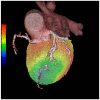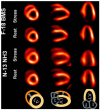Assessment of myocardial perfusion and function with PET and PET/CT
- PMID: 20379862
- PMCID: PMC2871404
- DOI: 10.1007/s12350-010-9223-5
Assessment of myocardial perfusion and function with PET and PET/CT
Figures










Similar articles
-
Myocardial perfusion PET/CT to evaluate known and suspected coronary artery disease.Q J Nucl Med Mol Imaging. 2010 Apr;54(2):145-56. Q J Nucl Med Mol Imaging. 2010. PMID: 20588211 Review.
-
Cardiac PET imaging for the detection and monitoring of coronary artery disease and microvascular health.JACC Cardiovasc Imaging. 2010 Jun;3(6):623-40. doi: 10.1016/j.jcmg.2010.04.007. JACC Cardiovasc Imaging. 2010. PMID: 20541718 Review.
-
Computed tomography myocardial perfusion vs 15O-water positron emission tomography and fractional flow reserve.Eur Radiol. 2017 Mar;27(3):1114-1124. doi: 10.1007/s00330-016-4404-5. Epub 2016 Jun 22. Eur Radiol. 2017. PMID: 27334015 Free PMC article.
-
PET measurement of absolute myocardial blood flow and LV function in dilated cardiomyopathy.JACC Cardiovasc Imaging. 2011 May;4(5):557-60. doi: 10.1016/j.jcmg.2010.06.020. JACC Cardiovasc Imaging. 2011. PMID: 21565745 No abstract available.
-
Semi-quantitative myocardial perfusion measured by computed tomography in patients with refractory angina: a head-to-head comparison with quantitative rubidium-82 positron emission tomography as reference.Clin Physiol Funct Imaging. 2017 Sep;37(5):481-488. doi: 10.1111/cpf.12322. Epub 2015 Dec 2. Clin Physiol Funct Imaging. 2017. PMID: 26625937
Cited by
-
PET/CT Myocardial Perfusion Imaging Acquisition and Processing: Ten Tips and Tricks to Help You Succeed.Curr Cardiol Rep. 2021 Mar 11;23(5):39. doi: 10.1007/s11886-021-01476-5. Curr Cardiol Rep. 2021. PMID: 33694057 Review.
-
The role of cardiac PET in diagnosis and prognosis of patients with ischemia with no obstructive coronary arteries (INOCA).Am Heart J Plus. 2024 May 18;43:100399. doi: 10.1016/j.ahjo.2024.100399. eCollection 2024 Jul. Am Heart J Plus. 2024. PMID: 38828445 Free PMC article.
-
Advances in Multimodality Cardiovascular Imaging in the Diagnosis of Heart Failure With Preserved Ejection Fraction.Front Cardiovasc Med. 2022 Mar 9;9:758975. doi: 10.3389/fcvm.2022.758975. eCollection 2022. Front Cardiovasc Med. 2022. PMID: 35355965 Free PMC article. Review.
-
Value of PET ECG gating in a cross-validation study of cardiac function assessment by PET/MR imaging.J Nucl Cardiol. 2023 Jun;30(3):1050-1060. doi: 10.1007/s12350-022-03105-2. Epub 2022 Sep 30. J Nucl Cardiol. 2023. PMID: 36180767 Free PMC article.
-
Current Concepts and Future Applications of Non-Invasive Functional and Anatomical Evaluation of Coronary Artery Disease.Life (Basel). 2022 Nov 7;12(11):1803. doi: 10.3390/life12111803. Life (Basel). 2022. PMID: 36362957 Free PMC article. Review.
References
-
- Beller GA, Bergmann SR. Myocardial perfusion imaging agents: SPECT and PET. J Nucl Cardiol. 2004;11:71–86. - PubMed
-
- Rimoldi OE, Camici PG. Positron emission tomography for quantitation of myocardial perfusion. J Nucl Cardiol. 2004;11:482–90. - PubMed
-
- Di Carli MF. Advances in positron emission tomography. J Nucl Cardiol. 2004;11:719–32. - PubMed
-
- Bengel FM, Higuchi T, Javadi MS, Lautamaki R. Cardiac positron emission tomography. J Am Coll Cardiol. 2009;54:1–15. - PubMed
-
- Di Carli MF, Dorbala S, Meserve J, El Fakhri G, Sitek A, Moore SC. Clinical myocardial perfusion PET/CT. J Nucl Med. 2007;48:783–93. - PubMed

